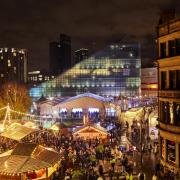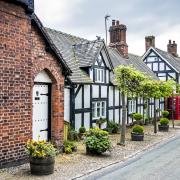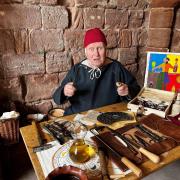This is one of those areas of countryside that looks, initially, rather unpromising on the map. It’s bounded by motorways and main roads, Stanlow Oil Refinery isn’t far away, and the tell-tale stippling of a landfill site looks oppressive on paper. However, once you set off from the village of Bridge Trafford, you’ll soon discover these eyesores are largely peripheral. Instead, you’ll enjoy peaceful reedbeds and water meadows with wader scrapes, a couple of pleasant hamlets and a popular wooded community space, through all of which the modest River Gowy flows placidly.
The refinery impinges on one’s consciousness only intermittently, though I was mildly amused by a house in Picton called Meadow View, whose bucolic name rather fixedly ignores the unignorable. On balance, the pastoral rewards of this easy, low-lying stroll easily outweigh the man-made intrusions, and there are ample opportunities for wildlife-watching.

Gowy Woodland Park is a pleasant area of woodland, grassy spaces and ponds on the landscaped site of a former tip. Before that, it was part of the estate of the (long-demolished) Bridge Trafford Hall. It’s well used – perhaps over-used – by dog walkers, but it’s mostly big enough, and the paths plentiful enough, to accommodate them. According to the interpretational panel on-site, wildlife inhabitants include barn owls, water voles and great crested newts. From the adjacent footbridge over the Gowy you overlook a series of shallow scrapes which, on my recent visit, produced some interesting bird sightings. We were also impressed by a fabulous display of meadow cranesbill, a swathe of nodding purple flowers blanketing a grassy slope.

Picton is a quiet hamlet on a back road. Nineteenth-century Picton Hall is listed at Grade II and features ‘trompe-l'œil’ painted panes to conceal windows bricked up to avoid taxes in the early 19th century. The ‘window tax’ – actually a flat tax on all dwellings with scaled increments for houses with more windows – was an early attempt to raise monies for the state without imposing a conventional income tax, which was seen as intrusive and illiberal. Adam Smith, the pioneering free-market thinker, considered it relatively inoffensive as a progressive system of means-testing since it did not require the indignity of granting an assessor entry to one’s residence, though he observed that the tax sometimes disproportionately impacted poorer rural home-owners over those with more valuable townhouses that perforce had fewer windows. The tax was repealed in 1851. The idea that the window tax inspired the phrase ‘daylight robbery’ is tempting, but appears to be a myth. For all that, the presence of blind windows on a building still provides a useful dating clue for the architectural detective.
1. From the Shrewsbury Arms, turn left. After a short distance, before the bridge over the River Gowy, turn left through a kissing gate onto a fenced footpath. By a gate, carry straight on – the path here winds through tall reeds and may look impassable, but persist. You may be serenaded by the insistent songs of sedge warbler and reed bunting as you swish through the reeds. Cross a footbridge and bear right, and you will shortly emerge from the reeds into a marshy meadow. Follow the fenced path to the River Gowy and cross the stile. There are some lagoons in the meadows to the left which, if you have binoculars, are worth a scan in case any interesting birds are lurking. Follow the river downstream and cross a further stile just before a footbridge.
2. Continue straight on past the bridge, to a third stile. Immediately beyond this, bear left, away from the river and to the right of the power lines. There’s no obvious path on the ground but you should find your way to a waymarked footbridge over a side stream to the right of a gateway. Keep right of a shallow channel in the meadow to a farm bridge over another ditch. Beyond this, bear half-right to a point where a hedge ends and a fence begins. Here, a stile gives on to a final field. Skirt around the left-hand edge of the field then climb another stile onto a fenced path that winds past houses and barns and out to the road in Picton.

3. Turn right and follow the road through the village, ignoring a couple of entrances on the left. Beyond the last house, follow the road round to the right, and continue along the quiet lane, keeping an eye out for occasional passing traffic, for a little over half a mile. It is on this stretch that the motorway, refinery and landfill site most obviously assert their presence.
4. At a left-hand bend, take a signposted footpath on the right that passes through a kissing gate next to a metal farm gate. The hedged green lane beyond may be a little overgrown, but soon disgorges into a field. At the bottom of the field, ignore a dodgy-looking farm bridge ahead over Mill Brook, instead turning right and keeping the watercourse on your left. Cross a footbridge over a perpendicular side ditch and continue past two fields planted with trees. Cross another footbridge, with double stiles, and continue along a narrow field to another bridge. Keep left in the next field to another double-stile footbridge in the left-hand corner, and continue to the far left-hand corner of the field beyond. Turn left over another footbridge and cross to yet another in quick succession. Beyond, keep right of a line of willow trees to yet another footbridge that returns you to the River Gowy.

5. Turn right and follow the riverbank upstream past a private farm bridge. Beneath the pylons you briefly retrace your steps to a footbridge over the river. This time, cross the river into Gowy Woodland Park.
6. Turn right, now with the Gowy on your right. The path eventually leaves the river and meets another path; turn right to the park entrance and noticeboard. Follow Hassalls Lane out to the main road and, to return to the Shrewsbury Arms, turn right.

The Shrewsbury Arms
Remarkably, Bridge Trafford had three pubs until fairly recently, but the Nags Head, after spells as restaurants offering varying cuisines and achieving equally varying levels of success, is now a furniture showroom. The Chester Fields is a barn conversion housing a bar, restaurant and wedding venue and is sometimes closed for private functions.
Thus, the traditional pubgoer is likely to head for the Shrewsbury Arms, as I did. This roadside pub has a sizeable car park – for patrons only – and a suntrap beer garden at the far end.
Inside, you’ll find a dog-friendly, comfortable wooden-floored interior. Hopefully if you’re walking this way in August you won’t need the open fires, but these days you never know…
There’s a fairly lengthy bar menu offering mostly pub staples – nothing wrong with that – and a decent range of vegan and vegetarian options. For lighter appetites, sandwiches and baguettes are available until 4pm (except Sundays), or, if you give the pub 24 hours’ notice, you could splurge on an afternoon tea with a glass of prosecco. (Aside: I’m not sure if this is an interesting factoid or an embarrassing admission of ignorance, but I only recently discovered that Prosecco is a place, near Trieste in Italy. Is it just me?)
The pub is open from noon daily, with food served until 8pm from Monday to Saturday and until 6.30pm on Sundays.
COMPASS POINTS
Area of walk: Bridge Trafford
Start point: Shrewsbury Arms (parking for patrons only)
Distance: 4 miles/6.2 km
Time to allow: 2 hours
Map: OS Explorer 266: Wirral and Chester
Refreshments: Shrewsbury Arms shrewsburyarmschester.co.uk
Practicalities: Several stiles. Short stretches may be overgrown, and low-lying meadows muddy after rain.



























